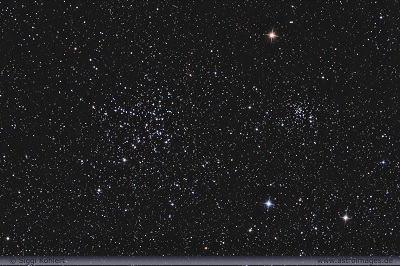M38 is the third and faintest of the three Messier open clusters located in the constellation of Auriga (the other two been M36 and M37). With an apparent mag. of +7.0, it's almost a magnitude dimmer than both M36 and M37, but still an easy binocular target. The cluster covers over 20 arc minutes of sky and hence due to its large size, is best observed at low magnifications with small to medium size telescopes.
Finding M38 is relatively easy. Start by locating the brightest stars in the constellation of Auriga, the Charioteer. This medium size constellation is positioned to the northeast of Taurus and to the northwest of Gemini. The main stars of Auriga form an easy to find large polygon shape, that's marked at the northern point by brilliant Capella. To trace the polygon, start with Capella then move eastwards in a circular like shape to Menkalinan (β Aur - mag. +1.90), followed by θ Aur (mag. +2.65), El Nath (β Tau - mag. +1.68), Hassaleh (ι Aur - mag. +2.69), then η Aur (mag. +3.18), Almaaz (ε Aur. - mag +3.03) and finally back to Capella. Now focus on stars θ Aur and El Nath and imagine a line connecting them. Located just east of the mid-point of this line is M37 with M36 to the west. Move 2.3 degrees northwest of M36 and you will arrive at M38.
As with M37, M38 was discovered by Giovanni Batista Hodierna sometime before 1654. The cluster was then rediscovered by French astronomer Guillaume Le Gentil in 1749 and subsequently added to his catalogue by Charles Messier on September 25, 1764. It's best seen from northern latitudes during the months of December, January and February.


Finder Chart for M38 - pdf format (credit:- freestarcharts)
M38 is beyond naked eye visibility. When viewed through 10x50 binoculars, it appears large and misty with the brightest stars just about resolvable, especially with averted vision. Larger 20x80 binoculars show a round, loose cluster of faint stars. The brightest members are easily visible with direct vision, with many fainter stars scattered throughout the cluster. A 100mm (4-inch) telescope reveals many members mainly concentrated towards the center, but with trails of stars streaming outwards. The bright stars are arranged in an irregular pattern that resembles an arrow, "X" shape or as is often referred to, a version of the Greek letter Pi.
When viewed through a 200mm (8-inch) scope at low powers, M38 is a nice sight. It almost fills the eyepiece field of view, appearing as a loose grouping with many bright stars visible in a circular type pattern. It is easy to make out the "X" shape amongst the stars and separating dark lanes. Quite a few stars are of the order of 9th or 10th magnitude, with many fainter stars interspersed amongst them. The brightest member of the cluster is a yellow giant star (type G0) of mag. +7.9, while many stars appear grouped in pairs. Adjacent to M38 on the southwest side is NGC 1907, a much smaller and fainter open cluster.
Although M38 is the faintest of the three Auriga Messier open clusters, it's still an excellent object that's best viewed with binoculars or through small / medium sized telescopes at low magnifications. The most prominent cluster feature is a grouping of bright stars that form a noticeable "X", arrow or Pi shaped structure.
M38 is located 4,200 light-years from Earth and has an apparent diameter of 21 arc minutes, which corresponds to a spatial radius of 25 light-years. In total, it contains about 100 stars and has an estimated age of 220 Million years.
M38 Data Table
| Messier | 38 |
|---|---|
| NGC | 1912 |
| Object Type | Open Cluster |
| Constellation | Auriga |
| Distance (light-years) | 4,200 |
| Apparent Mag. | +7.0 |
| RA (J2000) | 05h 28m 43s |
| DEC (J2000) | +35d 51m 18s |
| Apparent Size (arc mins) | 21 x 21 |
| Radius (light-years) | 25 |
| Age (years) | 220 Million |
| Number of Stars | 100 |
| Other Name | Collinder 67 |